


THE FRENCH REVOLUTIONARY WARS
1792 -
THE TREATY OF CAMPO FORMIO OCTOBER 1797
xxxxxIn 1796 the new Directory, grateful for his part in crushing the royalist uprising of October 1795, appointed General Bonaparte commander of a small, poorly equipped army to attack Sardinian and Austrian possessions in northern Italy. This campaign was seen as purely a diversionary tactic, while two powerful armies marched directly on Vienna. Despite the condition of his force, he inspired his men and led them on to a series of brilliant victories, first defeating the Sardinians at Mondovi, and then the Austrians in a string of battles, including those of Lodi, Arcole and Rivoli. He then set out to capture Vienna -
Including:
Baron Antoine
Jean Gros

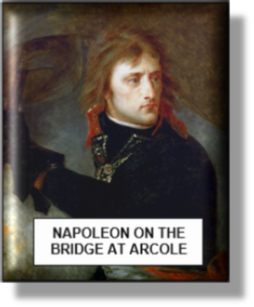 xxxxxAs we have seen, General Bonaparte’s “whiff of grapeshot” in October 1795, when thousands of royalist insurgents marched on the National Convention, saved the Republic in its hour of need. The new constitution came into effect the following month, and a grateful Directory appointed Bonaparte the “General of the Interior”. But revolutionary France still faced exterior threats and these had also to be dealt with. The Treaties of Basle, conducted in the first half of 1795, had knocked the stuffing out of the First Alliance, but Great Britain, Austria and Sardinia still remained at war with the republic. The Directory decided to seek further success on the battlefield in order to bring the conflict to an end and, incidentally and hopefully, to divert public attention from the serious inflation and growing unrest at home.
xxxxxAs we have seen, General Bonaparte’s “whiff of grapeshot” in October 1795, when thousands of royalist insurgents marched on the National Convention, saved the Republic in its hour of need. The new constitution came into effect the following month, and a grateful Directory appointed Bonaparte the “General of the Interior”. But revolutionary France still faced exterior threats and these had also to be dealt with. The Treaties of Basle, conducted in the first half of 1795, had knocked the stuffing out of the First Alliance, but Great Britain, Austria and Sardinia still remained at war with the republic. The Directory decided to seek further success on the battlefield in order to bring the conflict to an end and, incidentally and hopefully, to divert public attention from the serious inflation and growing unrest at home.
xxxxxLeaving island Britain aside for the moment, the plan of action devised by the military strategist Lazare Carnot involved a direct attack upon Germany by two well-
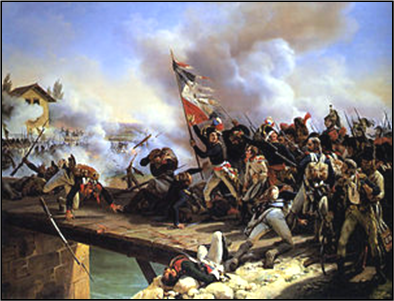
xxxxxFiguringxthat the Sardinians and Austrians would not expect an invasion over the winter months, he crossed the Alps north of Nice and entered Italy early in April 1796. The French army, he told the Italians, had come to break their chains. It had no quarrel save with “the tyrants who enslave you”. Then, true to his word, he swiftly drove a wedge between his two enemies and, turning on the Sardinians, defeated them at the Battle of Mondovi. He then bluffed them into making peace at Cherasco later that month by threatening to bring up a larger army if they refused to come to terms! As a result, Nice and Savoy, occupied by the revolutionary army in 1792, were annexed to France. Hexthen moved eastwards to take on the more formidable Austrians, and in this campaign he again showed his exceptional skill as a field commander, anticipating the time and place of battle, and manoeuvring his troops at speed to take advantage of his enemy’s weakest point. After his first successful encounter at Lodi, he occupied Milan and then defeated the Austrians in a series of encounters which included the Battle of Arcole (illustrated) in November 1796, and the Battle of Rivoli early in the New Year.
xxxxxThese victories enabled him to capture the stronghold of Mantua in February 1797, and then, having crossed the River Tagliamento, march north-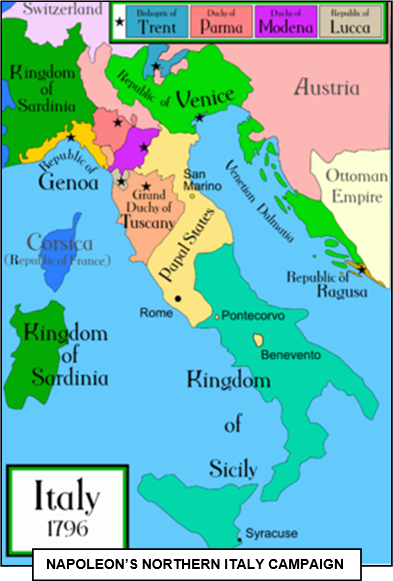 treasures, and accepting French control across the entire Po valley.
treasures, and accepting French control across the entire Po valley.
xxxxxDenied his opportunity to capture Vienna, Bonaparte chose to become the diplomat, much to the alarm of the Directory. Without reference to Paris, he redrew the map of northern Italy, creating the Cisalpine Republic and the Ligurian Republic (later incorporated into France), and drafting in person treaties with the Pope and the rulers of Parma, Modena, Genoa and Naples. Then in October 1797, having brought Austria to the peace table by his own endeavours, he himself negotiated the Treaty of Campo Formio, (a town near Udine in north-
xxxxxIn December 1797 Bonaparte came home to a hero’s welcome. The frontal attack upon Vienna via Germany had failed miserably. It was largely thanks to his endeavours that the Directory had now achieved the war aims sought for so long by the Bourbon monarchy it had replaced. France now stretched to the Rhine and the Alps, the natural boundaries which Louis XIV, with all his costly wars, had failed to achieve. Furthermore, the French were virtual masters of Italy, had annexed Belgium (the Austrian Netherlands) and made Holland a satellite state. And these gains had been internationally recognised. Of the First Coalition, formed against the new Republic in February 1793, only Great Britain was still at war, and this conflict was almost entirely confined to a battle at sea.
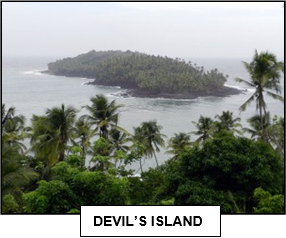 xxxxxBut the France Bonaparte returned to was not in a good state of repair. Over the past two years the Directory had been stumbling from one crisis to another, beset by soaring inflation, growing opposition to the new national church, and constant threats arising from conservative and radical revivals. In September 1797, for example, the Directors had been forced to carry out a drastic purge of parliament, transporting deputies with royalist sympathies to the penal colony of Devil’s Island off the coast of French Guiana -
xxxxxBut the France Bonaparte returned to was not in a good state of repair. Over the past two years the Directory had been stumbling from one crisis to another, beset by soaring inflation, growing opposition to the new national church, and constant threats arising from conservative and radical revivals. In September 1797, for example, the Directors had been forced to carry out a drastic purge of parliament, transporting deputies with royalist sympathies to the penal colony of Devil’s Island off the coast of French Guiana -
xxxxxFor his part, Bonaparte was now anxious to take on the British, and, as we shall see he did so in 1798, attacking Egypt to block their land route to India. However, by his highly successful campaign in Italy, both as a man of war and a maker of peace, he was seen by many as a ruler waiting in the wings. Nor did Napoleon himself conceal his ambitions in that direction. As he himself had said while fighting in Italy, “Do you think that it is to aggrandize the lawyers and the Directory that I triumph out here?” It was a loaded question, and one that would be answered within the space of two years.
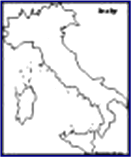 xxxxxIncidentally, by the end of Napoleon’s Italian campaign virtually the whole of the peninsula had come under French control. Then in 1798, Rome itself was occupied, and a Roman Republic proclaimed. In many parts, the Italian people welcomed Napoleon as a liberator, but despite his earlier promises, his rule was harsh in a number of ways. He imposed on them a heavy burden in taxation and military support, plundered their museums and art galleries, and acted without mercy against the slightest opposition to his authority. But his overthrow of Austrian rule had illustrated what could be achieved, and this had awakened the first stirrings of nationalism. This national awakening, the origins of what came to be known as the Italian Risorgimento, was to have a profound effect upon the history of Italy during the next century.
xxxxxIncidentally, by the end of Napoleon’s Italian campaign virtually the whole of the peninsula had come under French control. Then in 1798, Rome itself was occupied, and a Roman Republic proclaimed. In many parts, the Italian people welcomed Napoleon as a liberator, but despite his earlier promises, his rule was harsh in a number of ways. He imposed on them a heavy burden in taxation and military support, plundered their museums and art galleries, and acted without mercy against the slightest opposition to his authority. But his overthrow of Austrian rule had illustrated what could be achieved, and this had awakened the first stirrings of nationalism. This national awakening, the origins of what came to be known as the Italian Risorgimento, was to have a profound effect upon the history of Italy during the next century.
Acknowledgements
Battle of Arcole: by the French painter Horace Vernet (1789-
G3b-
xxxxxAfter the fall of Napoleon, his friend and former master David was forced into exile. Gros took charge of his studio and was made a baron. He produced some fine portraits during this late period, but his mythological scenes, in which he attempted to continue the studio’s classical ideals, proved unpopular with both the critics and the public. Distressed by his own failure and, above all, by David’s criticism of his efforts, he took his own life by drowning himself in the River Seine. As a romantic painter, the richness, free brushwork, and dramatic power of his painting greatly influenced his fellow artists and countrymen Théodore Gericault (1818 G3c) and Eugène Delacroix (1824 G4).
xxxxxThe French painter Antoine-
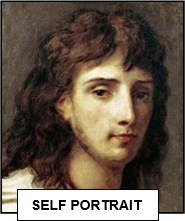 xxxxxThe painting above, Napoleon on the Bridge at Arcole, was the first major work of the Parisian Romantic painter Baron Antoine-
xxxxxThe painting above, Napoleon on the Bridge at Arcole, was the first major work of the Parisian Romantic painter Baron Antoine-
xxxxxGros was trained by his father, a painter of miniatures, and in 1785 joined the studio of his father’s friend Jacques-
xxxxxAlthough best known for his historical scenes, Gros was also an accomplished portrait artist. Shown here are details from (left to right): Dr. Vignardonne, Madame Bruyère, Baron Gérard, and Madame Pasteur.



